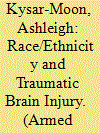| Srl | Item |
| 1 |
ID:
193008


|
|
|
|
|
| Summary/Abstract |
The COVID-19 pandemic reached all parts of historic Palestine around the same time, but by the end of December 2021, only 29.02 percent of Palestinians in the West Bank and Gaza were fully vaccinated compared to 63.82 percent of Israelis (including Palestinians with Israeli citizenship). The mortality rate from COVID-19 in the West Bank and Gaza was also higher, with 941.84 deaths per million, compared to 887.20 in Israel. This essay argues that these differences are a direct result of Israel’s COVID-19 response policies toward the Palestinians throughout the pandemic, as well as its ongoing siege of Gaza and its military occupation of the West Bank, including East Jerusalem. The analysis is framed through the lens of necropolitics, defined as the use of political power to decide who lives and who dies. Using the four waves of the COVID-19 pandemic across historic Palestine as a case in point, the essay focuses on the different political states in which Israel abused necropolitical power: the states of emergency, exception, siege, and acceptance.
|
|
|
|
|
|
|
|
|
|
|
|
|
|
|
|
| 2 |
ID:
163581


|
|
|
|
|
| Summary/Abstract |
The authors examine racial/ethnic differences in screening positive for traumatic brain injury (TBI) and in diagnosis among service members upon returning from war in Afghanistan and Iraq. Using data from the Post-Deployment Health Assessment and Re-Assessment, and military health-care encounters from 2008 to 2009, they estimate logistic regressions in a sample of 46,488 service members. Hispanic and Asian service members do not differ from White service members in screening positive for TBI but have 19% and 33% lower odds of diagnosis, respectively. Compared to White service members, Black service members are less likely to screen positive for TBI immediately after deployment and about as likely 3–6 months later, yet have 27% lower odds of diagnosis. Further, racial/ethnic minority service members have a lower probability of TBI diagnosis than White service members at all self-reported symptom levels, suggesting there is a discrepancy between symptoms and diagnosis related to race/ethnicity.
|
|
|
|
|
|
|
|
|
|
|
|
|
|
|
|